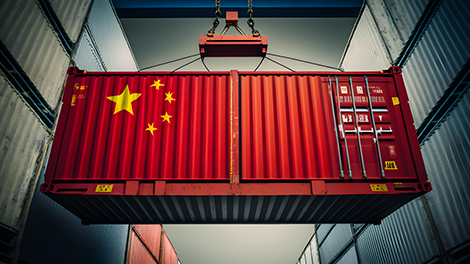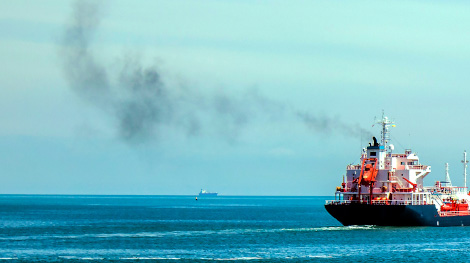Since 2005, the EU has had an Emissions Trading System (EU ETS) in place. A scheme which has been helping bring the bloc’s carbon emissions down, in pursuit of net zero targets.
Since January 2024, the application of EU ETS has been widened to include the maritime industry. All large vessels of over 5000 gross tonnage that dock at EU ports, regardless of the flag they fly, are subject to the scheme. A move which has had significant ramifications for shippers in the UK and EU. These ramifications could grow even further, now that in May 2025 the UK and EU agreed to link their ETS schemes.
In this article we will explore exactly what the EU’s Emission Trading System regulation means for sea freight shippers across Europe in 2025 and beyond.
What is the EU Emissions Trading System (EU ETS)?
In their own words, the EU ETS is “a cornerstone of the EU's policy to combat climate change and its key tool for reducing greenhouse gas emissions cost-effectively”.
Basically, it makes polluters in certain sectors pay compensation for their greenhouse gas emissions.
This works in the form of a cap-and-trade scheme. The ETS caps the total amount of CO2 that can be emitted from operators in targeted sectors. Then the operators have to purchase carbon allowances or trade them with other companies on a carbon market for every ton of CO2 emitted. The more emissions an operator is responsible for, the more carbon allowances they need to purchase. Failing to account for all emissions with allowances results in heavy fines.
In 2022, the average price of EU carbon allowances (EUAs) were £71 per tonne of CO2.
The UK and EU's agreement in May 2025 states that the UK and EU will link their ETS schemes. This means that companies will purchase these carbon allowances on the same marketplace. Therefore, prices will be more stable and UK businesses covered by the scheme avoid the EU Carbon Border Adjustment Mechanism when it's introduced.
Sectors covered by the scheme include over 10,000 installations in the energy generation sector, aviation, and manufacturing industries (such as oil refineries, metals, cement, lime, glass, ceramics, pulp, paper and more).
Since January 2024, the EU ETS has included maritime transport vessels above 5000 gross tonnes, which is why sea freight shippers need to be ready for changes.
The policy has been successful in reducing emissions in the target sectors to-date. The EU’s own estimations are that power and industry plant emissions have reduced 37% since 2005 because of the policy.
How is the EU Emissions Trading System being introduced for the maritime sector?
Since January 1st 2024, the EU ETS has covered 100% of the greenhouse gas emissions from intra-European voyages taken by ships of over 5000 gross tonnage. 50% of the emissions from voyages that start or finish in a EU port, will also be covered by the scheme.
However, to ensure a smooth transition, the implementation will be phased. Shipping companies only must surrender carbon allowances for a portion of their emissions during the phase-in:
- 2025: 40% of emissions from 2024 reported.
- 2026: 70% of emissions from 2025 reported.
- 2027: 100% of emissions from 2026 onwards reported.
Who in the maritime industry is responsible for paying the EU ETS costs?
Speaking directly, it falls to the shipping lines to purchase carbon allowances for the CO2 of their vessels. Failure to account for their emissions, and the fines that can result, is a risk that carriers will bear.
However, we all know it’s not that simple.
Shippers, freight forwarders, and other supply chain stakeholders have been paying these charges indirectly, in the form of surcharges that the carriers are adding to shipments.
How much is the EU ETS going to cost shippers?
Estimates are that this is the roughly $7 billion dollar question. That is the expected cost of this widening of the EU ETS regulation.
All the major shipping lines have published their EU ETS surcharge estimates. They are as follows:
| Trade | Maersk per TEU | ONE per TEU | CMA CGM per TEU | ZIM per TEU | Yang Ming per TEU | Hapag-Lloyd per TEU | Evergreen per TEU | MSC per TEU | COSCO per TEU | HMM per TEU | OOCL per TEU |
| Asia - North Europe | £17 | £20 | £22 | n/a | £21 | £20 | £23 | £18 | £16 | £14 | £23 |
| Asia - Med | £9 | £14 | £17 | n/a | £16 | £19 | £20 | £15 | £16 | £12 | £16 |
| Europe - North America | £20 | £26 | £34 | £32 | £23 | £21 | £28 | £30 | £36 | £35 | £40 |
Source: The Loadstar. Values converted from € to nearest £.
Unfortunately, those figures aren't certain. They are only estimates. But they are a good indication that we aren't talking about huge new charges and that the rates are expected to be broadly the same across the shipping lines. They only vary £6 per teu on the Asia – North Europe trade lane, £11 on Asia – Mediterranean routes and £19 on European exports to North America.
How does the May 2025 UK-EU deal impact UK shippers regarding ETS?
As of May 2025, the UK and EU have announced a deal which will see their ETS schemes linked. This means that the UK will join the carbon credit market of the EU. However, there's no confirmation currently whether UK requirements for ETS will be brought in line with the EUs. Both are currently operating on different timelines in maritime transport.
At present, maritime transport is not covered by the UK ETS, and although that changes in 2026, it only applies to domestic maritime transport over 5,000GT.
This is different from the EU's existing requirement to purchase carbon credits for 100% of the emissions from a maritime journey's starting and finishing in the EU. Or, for 50% of the emissions from voyages that start or finish outside the EU.
Currently the only details are that the carbon credit markets will be linked. There have been no details on alignment of legislation related to maritime transport.
As it happens, most UK shippers are already subject to EU ETS charges anyway on international shipments.
As most container lines make multiple calls in North Europe, when other calls are within the EU, that ship becomes liable for EU ETS charges. Whether that is Antwerp, Rotterdam, Hamburg, or others. At that point, any shipper with containers on board is required to pay surcharges. Even if their containers' destination is London Gateway, Southampton, Felixstowe or another UK port.
Are shipping lines going to change their routes to avoid EU ports?
With the UK's more relaxed laws on ETS currently, some shipping lines have been favouring an initial call at a UK port such as Felixstowe or London Gateway, before moving onto EU ports. With the current rules, this means shipping lines only have to pay for the emissions on the leg of the journey between the UK and EU port, not all the way from Asia.
What if my goods are on a zero-emission or low-emission vessel?
Whilst options are limited currently, in the years to come there will be a growing number of zero or low-emission vessels in operation on major trade lanes. Maersk took delivery of its first large ocean-going 16,000 TEU methanol-powered vessel in Q1 of 2024.
So, will using these vessels avoid the charges? In theory, yes. But that will depend on how the carriers decide to charge for their carbon allowances.
They could take their total EU ETS charge and divide it equally, per teu, amongst shippers on a certain trade lane. Or they could calculate their ETS charges on a vessel-by-vessel basis. Meaning if you opt for a zero or low-emission vessel, you avoid most, if not all, charges.
Ultimately, it’s a move that incentivises these new, green, fuel-efficient vessels. Which is what the EU wants (and the planet needs), of course.
In the immediate future, it’s certainly true that the shipping lines with newer, more fuel-efficient fleets will have lower EU ETS charges. Therefore, making themselves more price competitive.

Is China still the world's import hub?
This latest in-depth research report evaluates China's status as the world's import hub; examining the economic and political changes which could inspire businesses to look elsewhere.
Whilst these charges are a burden for the logistics industry and shippers particularly, the sector is under increasing pressure to decarbonise. This is just one of many regulations that businesses using the industry can expect in the coming years as pressure mounts.
Businesses should build managing and reducing their environmental impact into their strategic plans for the years to come. The WTA Platform allows businesses to track the emissions of their entire supply chain, using our ISO-compliant tracing tool. From there you're able to make route and container optimisations, lowering your impact and leaving you better prepared for the incoming net-zero targets. Which are increasingly the expectation from consumers. Book a demo of the WTA Platform now.







